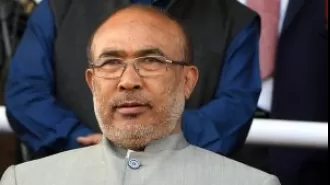UN report says Earth is headed towards much greater warming than previously thought.
The UN's Emissions Gap Report suggests reducing emissions by half a degree could help mitigate extreme weather events, but more action is needed.
October 24th 2024.

According to a recent report by the United Nations, the world is facing a significant increase in temperature of 1.8 degrees Celsius. However, there is still hope to reduce this projected warming by half a degree if countries follow through on their promises to combat climate change. This could potentially minimize the severe impacts that come with rising temperatures, such as extreme heat waves, wildfires, storms, and droughts.
The report, released on Thursday, states that even with all the efforts put forth by countries, it will not be enough to prevent the worst consequences of climate change. The only scenario in which the internationally agreed-upon limit of 1.5 degrees Celsius could be achieved is the most optimistic one, with significant cuts in the burning of fossil fuels. However, this scenario is unlikely, and the chances of limiting warming to 1.5 degrees are virtually zero.
The goal set in the 2015 Paris Agreement was to keep the human-caused warming to 1.5 degrees Celsius since pre-industrial times. However, the report reveals that since the mid-1800s, the world has already warmed by 1.3 degrees Celsius, higher than previous estimates of 1.1 or 1.2 degrees, due to record-breaking heat last year. At the current pace, the world is on track to hit 3.1 degrees Celsius since pre-industrial times, which is well above the agreed-upon limit.
But there is a glimmer of hope. If countries fulfill all their promises and targets submitted to the United Nations, the warming could be limited to 2.6 degrees Celsius. However, this would require strict and immediate cuts in carbon emissions, with the goal of reaching zero net emissions by the middle of the century. In this scenario, there is a 23% chance of keeping warming below the 1.5 degrees goal. However, the report also warns that it is more likely that even this optimistic scenario will only limit warming to 1.9 degrees above pre-industrial times.
Anne Olhoff, the main editor of the report, emphasizes the urgency of taking action before 2030 to lower the temperature. She states that it is now or never if we want to keep the 1.5 degrees goal alive. UNEP Director Inger Andersen also stresses the need for swift and dramatic emission cuts, stating that without them, the 1.5 degrees goal will soon be unattainable, and the world will face even worse warming of 2 degrees or more.
The report also reveals that one of the main problems is the gap between what countries have promised to do and what they are actually doing to reduce emissions. The world's 20 richest countries, responsible for 77% of carbon pollution, are falling short of their emission-cutting goals, with only 11 meeting their individual targets.
According to the report, it is entirely possible to achieve the emission cuts needed to limit warming to 1.5 degrees, but the proposed actions are not being taken. Climate scientist Bill Hare states that the report once again shows that governments are not doing enough to combat climate change. Another scientist, Johan Rockstrom, confirms this, saying that the world is now on a path to disaster with a 3.1 degree warming, and there is almost no uncertainty about it.
The report also highlights the fact that the calculations of 3.1 and 2.6 degrees are only a tenth of a degree warmer than last year's report, which is within the margin of uncertainty. However, the issue is that there is one less year to make necessary cuts in emissions, and every year counts in the fight against climate change.
John Sterman, a researcher who models different warming scenarios, states that winning slowly is equivalent to losing in the context of climate change. He emphasizes that time is running out, and the consequences of inaction will be catastrophic. The report focuses on the emissions gap, which calculates the budget for greenhouse gas emissions needed to stay under 1.5, 1.8, and 2 degrees of warming. It also determines the annual emissions cuts required by 2030 to achieve these goals.
To keep warming at or below 1.5 degrees, emissions must be slashed by 42%, and for 2 degrees, it must be 28%. However, in 2023, the world emitted 57.1 billion metric tonnes of greenhouse gases, equivalent to 1,810 metric tonnes per second. United Nations Secretary-General Antonio Guterres stresses the direct link between increasing emissions and more frequent and intense climate disasters. He warns that we are playing with fire and have no more time to spare. It is time to take immediate and drastic action to combat climate change before it is too late.
The report, released on Thursday, states that even with all the efforts put forth by countries, it will not be enough to prevent the worst consequences of climate change. The only scenario in which the internationally agreed-upon limit of 1.5 degrees Celsius could be achieved is the most optimistic one, with significant cuts in the burning of fossil fuels. However, this scenario is unlikely, and the chances of limiting warming to 1.5 degrees are virtually zero.
The goal set in the 2015 Paris Agreement was to keep the human-caused warming to 1.5 degrees Celsius since pre-industrial times. However, the report reveals that since the mid-1800s, the world has already warmed by 1.3 degrees Celsius, higher than previous estimates of 1.1 or 1.2 degrees, due to record-breaking heat last year. At the current pace, the world is on track to hit 3.1 degrees Celsius since pre-industrial times, which is well above the agreed-upon limit.
But there is a glimmer of hope. If countries fulfill all their promises and targets submitted to the United Nations, the warming could be limited to 2.6 degrees Celsius. However, this would require strict and immediate cuts in carbon emissions, with the goal of reaching zero net emissions by the middle of the century. In this scenario, there is a 23% chance of keeping warming below the 1.5 degrees goal. However, the report also warns that it is more likely that even this optimistic scenario will only limit warming to 1.9 degrees above pre-industrial times.
Anne Olhoff, the main editor of the report, emphasizes the urgency of taking action before 2030 to lower the temperature. She states that it is now or never if we want to keep the 1.5 degrees goal alive. UNEP Director Inger Andersen also stresses the need for swift and dramatic emission cuts, stating that without them, the 1.5 degrees goal will soon be unattainable, and the world will face even worse warming of 2 degrees or more.
The report also reveals that one of the main problems is the gap between what countries have promised to do and what they are actually doing to reduce emissions. The world's 20 richest countries, responsible for 77% of carbon pollution, are falling short of their emission-cutting goals, with only 11 meeting their individual targets.
According to the report, it is entirely possible to achieve the emission cuts needed to limit warming to 1.5 degrees, but the proposed actions are not being taken. Climate scientist Bill Hare states that the report once again shows that governments are not doing enough to combat climate change. Another scientist, Johan Rockstrom, confirms this, saying that the world is now on a path to disaster with a 3.1 degree warming, and there is almost no uncertainty about it.
The report also highlights the fact that the calculations of 3.1 and 2.6 degrees are only a tenth of a degree warmer than last year's report, which is within the margin of uncertainty. However, the issue is that there is one less year to make necessary cuts in emissions, and every year counts in the fight against climate change.
John Sterman, a researcher who models different warming scenarios, states that winning slowly is equivalent to losing in the context of climate change. He emphasizes that time is running out, and the consequences of inaction will be catastrophic. The report focuses on the emissions gap, which calculates the budget for greenhouse gas emissions needed to stay under 1.5, 1.8, and 2 degrees of warming. It also determines the annual emissions cuts required by 2030 to achieve these goals.
To keep warming at or below 1.5 degrees, emissions must be slashed by 42%, and for 2 degrees, it must be 28%. However, in 2023, the world emitted 57.1 billion metric tonnes of greenhouse gases, equivalent to 1,810 metric tonnes per second. United Nations Secretary-General Antonio Guterres stresses the direct link between increasing emissions and more frequent and intense climate disasters. He warns that we are playing with fire and have no more time to spare. It is time to take immediate and drastic action to combat climate change before it is too late.
[This article has been trending online recently and has been generated with AI. Your feed is customized.]
[Generative AI is experimental.]
0
0
Submit Comment





